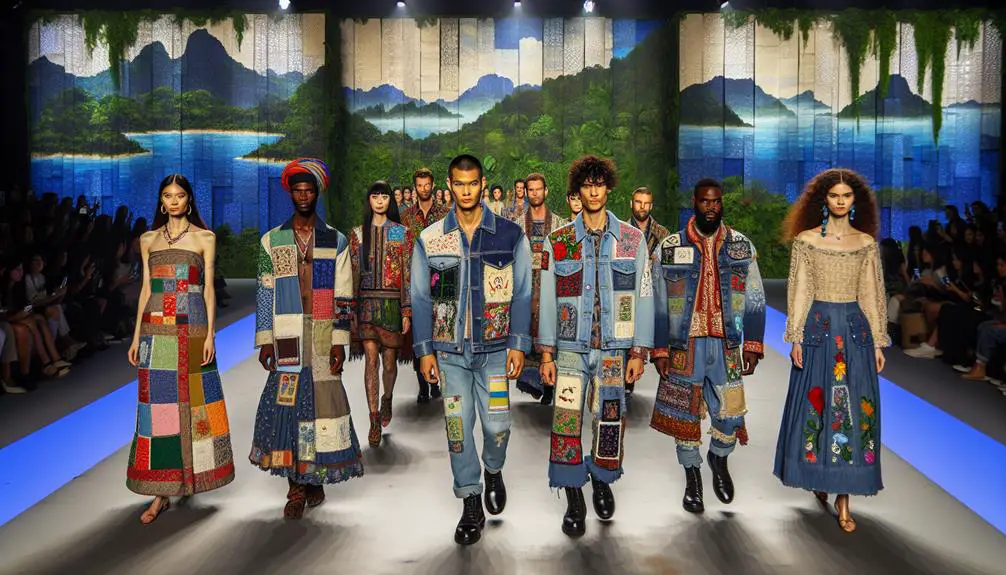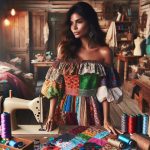Imagine taking something destined for the trash and transforming it into a fashionable piece of clothing. Upcycled fabrics do just that, turning waste into stylish and sustainable garments. This approach not only reduces waste but also fosters a circular economy and promotes ethical practices. By embracing upcycled fabrics, you support unique, eco-friendly fashion that highlights creativity and innovation. Curious about how to start or interested in popular upcycling techniques? There's a lot more to uncover about the benefits and the future of this transformative trend.
Table of Contents
Key Takeaways
- Upcycled fabrics reduce waste and support sustainable, ethical fashion.
- Transforming discarded materials into unique garments lowers the carbon footprint.
- Techniques like patchwork and visible mending create stylish, standout pieces.
- Brands like Patagonia and Stella McCartney lead by integrating upcycled fabrics.
- Eco-conscious consumers drive demand for innovative upcycled fashion.
Benefits of Upcycled Fabrics
By choosing upcycled fabrics, you're not only reducing waste but also supporting a more sustainable and ethical fashion industry. The environmental impact of conventional fabric production is significant, with high water usage, chemical runoff, and carbon emissions. By opting for upcycled materials, you actively reduce these negative effects.
Upcycling takes existing textiles that would otherwise end up in landfills and transforms them into something new and valuable. This process requires fewer resources compared to producing new fabrics, effectively lowering your carbon footprint.
You're also contributing to the broader goal of sustainable fashion. The industry is notorious for its wastefulness and exploitation. Upcycled fabrics challenge this status quo by promoting a circular economy. Instead of a linear path where items are produced, used, and discarded, upcycling encourages reuse and longevity. This shift helps in conserving raw materials and reducing the need for new production.
Moreover, upcycled fabrics often come with a story and uniqueness that mass-produced items lack. Each piece can offer a distinct aesthetic, giving you the opportunity to wear fashion that's both stylish and responsible. By embracing upcycled fabrics, you're making a statement that aligns with both environmental stewardship and cutting-edge fashion.
Popular Upcycling Techniques
Several innovative techniques have emerged to transform discarded textiles into fashionable upcycled fabrics. One essential method is creative stitching, which allows you to breathe new life into old garments. By employing intricate embroidery, patchwork, or even visible mending, you can turn fabric scraps into unique fashion statements. This technique not only extends the life of your textiles but also adds a bespoke touch that mass-produced items can't replicate.
DIY projects are another popular approach. When you frequent thrift stores, you'll find a treasure trove of potential waiting to be upcycled. Old jeans can become stylish tote bags, or oversized shirts can be refashioned into chic dresses. The key is to see beyond the garment's current state and envision its potential. Armed with basic sewing skills and a creative mindset, you can transform thrift store finds into standout pieces.
Additionally, combining various fabric scraps can result in eye-catching patchwork designs. This method is particularly effective for creating quilts, jackets, and accessories that not only reduce waste but also showcase your originality. By mastering these techniques, you'll contribute to a more sustainable fashion industry while expressing your personal style.
Success Stories in Fashion
Many designers and fashion brands have already embraced upcycling techniques, turning waste materials into stunning collections that have gained global recognition. You've probably heard of Stella McCartney, a pioneer in sustainable practices, who's integrated innovative designs using upcycled fabrics into her collections. Her commitment to reducing waste while maintaining high fashion standards is truly inspiring.
Another notable success story is Patagonia. The brand doesn't just talk the talk; it walks the walk by upcycling discarded garments into new, functional pieces. Patagonia's Worn Wear program exemplifies how sustainable practices can be seamlessly woven into a business model, proving that eco-friendly fashion isn't only possible but profitable.
You can't overlook the influence of small but mighty brands like E.L.V. Denim. They transform old jeans into modern, stylish pieces, showcasing how creativity knows no bounds when it comes to upcycling. Their innovative designs have captured the attention of fashion enthusiasts and eco-conscious consumers alike.
These brands are just a few examples of how upcycling can elevate fashion to new heights. By embracing sustainable practices, they're not only reducing waste but also setting new industry standards.
How to Start Upcycling
Getting started with upcycling is simpler than you might think. First, focus on sourcing materials. Scour thrift stores, garage sales, or even your own closet for items with potential. Look for fabrics that are durable and unique. Once you have a collection, the real fun begins: creating designs. Sketch your ideas, mix different textures, and think outside the box. Don't be afraid to experiment; innovation is key in upcycling.
Next, it's time to think about marketing products. High-quality photos are essential. Showcase your creations with clear, well-lit images that highlight the details. Use social media platforms to reach a broader audience and engage with potential customers. Share your journey and the story behind each piece to create a connection.
Building a brand comes down to consistency and authenticity. Develop a logo and a cohesive visual style that reflects your aesthetic. Be transparent about your process and the environmental benefits of upcycling. This authenticity will resonate with eco-conscious consumers.
Future of Upcycled Fashion
The future of upcycled fashion looks incredibly promising as more designers and consumers embrace sustainability. You'll notice that sustainable innovation is at the forefront, pushing the boundaries of what's possible in eco-friendly trends.
Designers are now experimenting with cutting-edge techniques to transform waste materials into chic, high-quality garments. Imagine wearing a stunning dress made from recycled plastic bottles or a stylish jacket crafted from discarded fishing nets. These aren't just imaginative concepts; they're becoming mainstream.
As a savvy consumer, you'll find that the market is responding to your demand for eco-friendly trends. Brands are increasingly transparent about their sourcing and production processes, ensuring you know exactly where your clothes come from and how they're made. This shift towards transparency isn't just good for the planet; it also cultivates trust and loyalty.
You're not just a passive observer in this movement; you're an active participant. By choosing upcycled fashion, you're driving the demand for sustainable innovation. You're making a statement that fashion doesn't have to come at the expense of the environment.
The future is bright, and you're at the heart of this transformative journey.
Frequently Asked Questions
What Materials Are Considered Suitable for Upcycling Into Fabrics?
You can transform various materials into upcycled fabrics, including textile waste like old clothing, fabric scraps, and used home textiles. Embracing these materials supports sustainable fashion and minimizes environmental impact, showcasing your commitment to eco-friendly practices.
How Does Upcycled Fabric Impact the Overall Cost of Clothing?
Imagine wearing a garment that symbolizes both cost savings and environmental benefits. Upcycled fabric impacts clothing costs by lowering production expenses, boosting design possibilities, and meeting market demand for sustainable fashion, appealing to eco-conscious consumers.
Are Upcycled Fabrics Durable and Long-Lasting Compared to New Fabrics?
You'll find upcycled fabrics offer impressive durability and longevity, often matching or surpassing new fabrics. Their sustainability enhances environmental impact, making them a wise choice for eco-conscious consumers seeking quality and lasting value in clothing.
What Certifications or Standards Exist for Upcycled Fabrics?
Imagine a seal of approval as a golden ticket. Certifications like Global Recycled Standard and OEKO-TEX guarantee upcycled fabrics meet industry regulations, highlighting their environmental impact and ethical sourcing, boosting consumer awareness and trust.
How Can Consumers Identify Clothing Made From Upcycled Fabrics?
To identify clothing made from upcycled fabrics, check for labels and marketing strategies highlighting sustainable fashion. Brands often promote eco-friendly choices, increasing consumer awareness. Look for certifications, transparency reports, and eco-conscious packaging to guide your decision.
- The Use of Nonwovens in Construction and Civil Engineering - July 11, 2025
- The Use of Nonwovens in Construction and Civil Engineering - July 11, 2025
- The Use of Nonwovens in Construction and Civil Engineering - July 11, 2025







